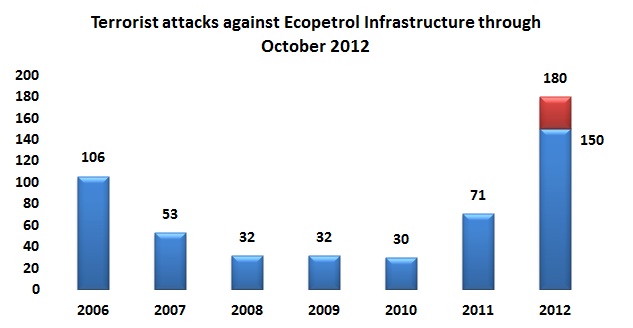National weekly news magazine Semana published a report about the country’s regions where the most organized violent incidents are happening. According to the report, the division splintering of large criminal organizations has led to the emergence of criminal gangs seeking to appropriate the local illicit business.

In our Inner Circle Exclusive Monthly Report for November we published MinDefensa figures that showed hydrocarbons infrastructure attacks were down to 196 in 2011 from 917 in 2002. The graph shows the importance of picking your measurement dates to make your point. The Defense Minister implied (but did not say) that there had been a steady decline from 2002 to 2011. We obtained this data for attacks on Ecopetrol and they clearly show a rather dramatic increase since 2010 – the start of the Santos presidency – from about 30 during the later years of Uribe’s second term to 150 as of the end of October 2012.
Incidents were down this week, returning the average for the last four weeks. The vast majority of these were the Army continuing to discover camps, minefields and weapons caches so perhaps the Farc are keeping up their truce commitment.
As we predicted, incidents were way up this week after having fallen for five straight weeks. The vast number of incidents were reported by the Colombian Armed Forces so it was clear the government was responsible for turning up the heat. The Colombian government never agreed to lay down their arms so this is not surprising. This is not to say the Farc were angels or that the self-declared truce was being observed perfectly, but there were fewer of these. ‘Somebody’ blew up two electrical towers in Antioquia and the departmental government thinks it was the Farc.

The Family Welfare Branch of the National Army (JEFAM) and Ecopetrol launched “Plan Padrino”. This plan seeks to provide support to soldiers wounded in pipeline areas in the following departments: Santander, Arauca, Magdalena, Nariño y Putumayo.
National business newspaper La Republica reported that Ecopetrol says that despite the attacks of 17 November to Transandino pipeline, management expects to meet its goal of producing around 780,000 bpd on average by the end of this year. Note that this figure is likely production before royalties (see our November Monthly Report). We estimate it is the equivalent of about 655,200 bpd as usually measured (Net of Working Interest and Royalties).
The Farc surprised everyone last Friday by announcing a unilateral truce to last for two months. They said they were suspending all attacks against civilian, government and private targets. Of course, they had just blown up the TransAndino pipeline the day before so they went out with a bang so to speak. The government immediately said they would not reciprocate, consistent with their line since the beginning of the peace process. What is worrisome are rumors that Farc commanders in the south may not comply with their leaders’ orders.
Incidents were down again slightly this week perhaps disproving our hypothesis that things would heat up around the resumption of peace talks next week. Quantity may be down but severity would seem to be up.
RCN Radio reports that the Farc are assumed to be responsible for an explosives attack on the TransAndino pipeline in two separate locations. The first was in the village of El Verde in municipality of Puerres in the department of Nariño and the second was a few kilometers away in the village of San Pablo in the municipality of Cordoba in the same department. Both are located near the border with Putumayo.
Incidents declined again for a fourth straight week but the decline was slight so maybe we have found a new equilibrium.